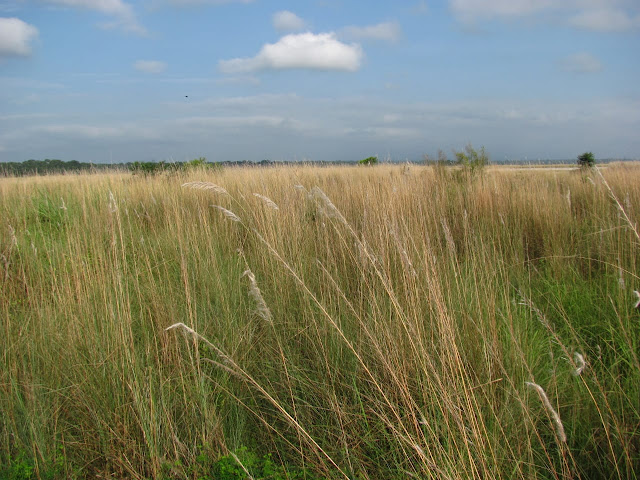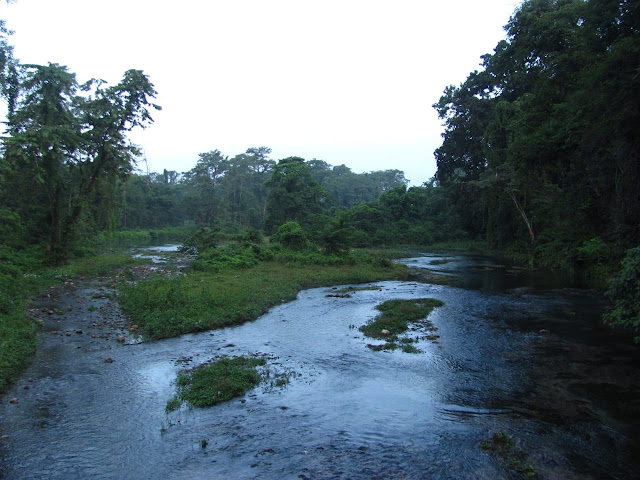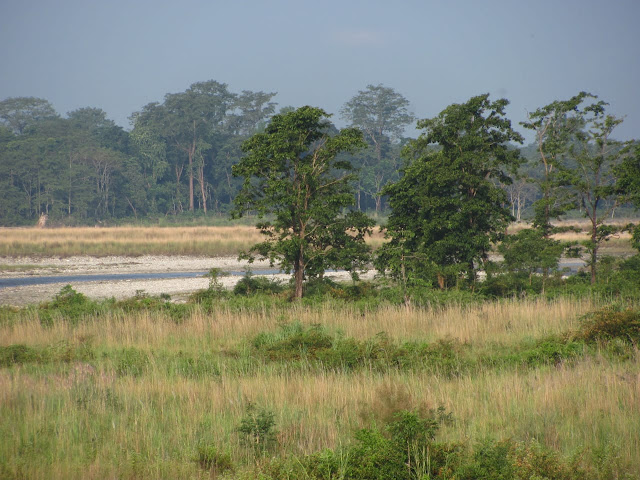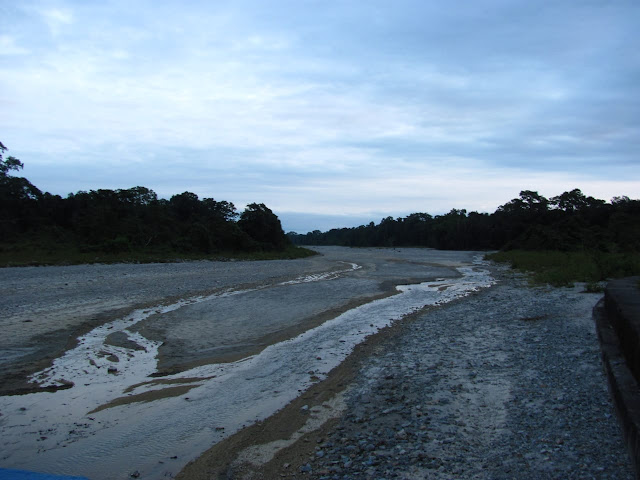 |
| The woods of Jaldapara National Park |
Over the years
Garumara & Jaldapara has been extremely successful in conserving the one
horned rhinoceros. While Garumara is much bigger in area, in terms of
aesthetics, Jaldapara is extremely appealing.
The vast grasslands
along Torsha, one of the most beautiful river of north Bengal , make it an ideal
habitat for the rhinoceros.
 |
| The famous elephant grass of Jaldapara |
When it comes to Jaldapara, most of us think of
Hollong – the sought after tourist rest house inside the core area of the
forest. While I have been lucky to spend couple of nights in Hollong, there’s
one more place, which is extremely underrated yet very beautiful.
You guessed it right.
I’m talking about the WBFDC Malangi Lodge at Barodabri. Situated just
beside the Barodabri beat of Jaldapara NP, this place is largely underrated,
but believe me, it’s one of the most beautiful places to enjoy the forest and
the sylvan surroundings of Jaldapara.
Reaching Malangi
We reached Malangi
after almost a 16 hours long train journey from Kolkata. Unfortunately the
KanchanKanya Express got a delayed arrival at Siliguri, and since from Siliguri
to Alipurduar Junction it runs through a single line track, if it gets delayed
in Siliguri, it continues to make more unscheduled halts for passing trains
from opposite direction.
 |
| KanchanKanya Through Dooars |
We reached Hasimara
almost 3 hours late at 1 p.m. Luckily the Malangi lodge is not far from the Station.
It took a little more than 15 minutes in a Car and we reached the lodge by 1.30
p.m. The forest department has created the lodge inside a big compound. There’s
ample greenery and ample spaces to roam around and enjoy the aromatic breeze
coming from the forest.
 |
| The backside of WBFDC Malangi Lodge |
Regarding the rooms, there are two wings in the lodge.
The old block on the front side and the new at the back. We got the Rydak room
on the old block, and I would say Rydak and Sankosh room are the two best
rooms in WBFDC Malangi. They have a balcony in front, big in size, and wood paneled,
making it extremely comfortable both in summers and the winters.
After freshening up,
we quickly enquired if there’s any vacancy available for the evening Chilapota
Forest Safari. The Chilapota forest is around 10 kilometers from Malangi
towards Coochbehar, and it’s said to be one of the densest forests in North
Bengal. But unfortunately all seats were booked. So for the afternoon, we only
had the option to roam around the vicinity.
 |
| Malangi River at the back of WBFDC lodge |
After a homely lunch
and a quick nap, at around 3.30 p.m, we decided to venture out. A 500 meter
walk from the hotel compound, through the forest, will take you to the banks of
Malangi river which runs through the Jaldapara National Park. It’s more of a
rivulet, but the beauty of the river flowing through the thickly wooded forest
is absolutely enticing.
There is a wooden pool
to cross the Malangi river, but that’s absolutely not advisable, because the moment you
cross the pool, you are into the core zone of the Jaldapara NP. The gurgling
brook through the silent forest was really an audio visual retreat. There were
nobody except us, and we just soaked the silence and the scent of the forest
for almost couple of hours.
We could see lots of
Peacocks, coming to quench their thirst and also a solitary wild boar on the
opposite bank.
 |
| Forest Guard - Riding over the Wooden pool at river Malangi |
Just when the dusk was
setting in, from about 200 meter from the pool, we saw couple of Indian Bison. It
was really thrilling to see wildlife, from such close quarters.
We were planning to
stay half an hour more after the sunset, but a forest guide, who was crossing
the pool in his bicycle and returning to home, advised us to get back, as it
was too risky to stray around the forest in the dark.
Elephant Safari – The next morning
The next morning we
had booked our elephant safari at Barodabri beat. There are 3 slots of one hour each for the
safari, from 5.30 a.m. to 8.30 a.m. We booked the middle one starting at 6.30
a.m.
A forest department
car would come to Malangi lodge to pick the tourist and will take you almost 2
kilometers deep inside the forest where the Elephant Riding facility is
available. We reached at around 6.15 a.m, and the first trip was still in
progress. So we climbed the watch tower in the vicinity and enjoyed a bird’s
eye view of the entire Barodabri Beat of the Jaldapara NP.
 |
| Torsha river grassland Jaldapara- from watchtower |
It was late autumn,
so the vast grassland on the Torsha riverbank was full of golden yellow color.
We could see the Torsha river, flowing in its languid charm through the sylvan
settings. On the backdrop we could also see the rolling hills of Bhutan.
Pointing at the
grasslands our guide said, it’s the favorite place for the Barking Deer’s and
the Sambhar’s to roam around. The rhino’s also love to stay around the river,
so that they can have a dip at the river whenever they want.
Meanwhile our Elephant
and its Mahout also came back from the first trip, and it is now our turn to
enjoy the forest on the back of an elephant.
Our elephant in its
majestic gait, entered into the deep forest. We have to go through the deep
forest towards river Torsha and the grasslands were there’s highest possibility
of rhinoceros sighting.
 |
| Barking Deer at Jaldapara |
While roaming through
the thick woods, we saw various birds, including the illusive Hornbill. Riding
an elephant has a completely different charm, than roaming in a jeep. Elephant
can reach spots where jeeps can’t and hence the sighting always tends to be
better. Within next 15 minutes we saw a pair of Indian Bison, A barking deer
and a pack of wild buffalo.
As we came closer towards the riverbank, the thick
woods disappeared, and we entered into the land of tall grasses. Our Mahout was
following the footprint of a male Rhino, and tracking the trail, we came into
the banks of River Torsha.
The Rhino Spotting
We spotted the rhino
almost immediately at torsha riverbank. The giant was dipping itself into the shallow water of Torsha
and was enjoying the cold water. We were really thrilled. He didn’t show any
signs of discomfort, which meant even after seeing us he will not move away
from the water, which will give us ample opportunity to enjoy the gorgeous
animal from much closer.
 |
| Rhino Spotting at Torsha Riverbank - First Look |
Our Mahout slowly
guided his elephant to come closer to the rhino, and we came really close. We
waited there for almost 10 minutes, enjoying the lovely creature. Initially it
was nonchalant about our presence, and we got some great closeups of the Indian rhino, but just when we tried to be too close
towards him, he gave a warning sign by throwing out a heavy breathe into the
water. Our experienced Mahout understood the signal, and we slowly departed.
When you are in forest, you have to respect the animals and their body
language.
We crossed the river,
and went into the opposite side. We were looking for few more rhinos, and
luckily we got another.
 |
| Closeup of Indian Rhino at Jaldapara |
This time the rhino
was hiding behind the tall grasses, so the sighting was not that clear. But
since it was not submerged, we got a full view of it. We could also see his
gorgeous horn. it’s the demand of their horn in the market, which makes this
lovely animal so vulnerable to poaching.
Our elephant was
standing almost face to face with this Rhino, and it didn’t look very pleased
with our presence. So we didn’t wait more than couple of minutes, and then
turned back. Crossed the river, and came back to the watchtower.
 |
| Indian One horned Rhino at Jaldapara - Close up shot |
The one hour
ride was really enticing. The ride in the back of elephant through the rugged forest landscape really has its own charm. The beauty of the forest and the presence of the wildlife
made it perfect.
Towards Jayanti
After breakfast we
started our trip towards Jayanti. Jayanti a small little village inside the
Buxa tiger reserve is famous for the majestic view of lofty Bhutan hills and the
gorgeous Jayanti riverbed.
From Malangi, Jayanti
is about 40 kilometers, and the drive through the tea gardens is beautiful. We
started at around 10 a.m, passing through Kalchini, Hamiltonganj and reached
Rajabhatkhawa within an hour. Rajabhatkhawa is the entry point of Buxa tiger
reserve. We paid for the necessary permit, at the forest check post, and
entered into the core zone of Buxa tiger reserve.
 |
| The tea gardens of Eastern Dooars |
Buxa is famous for its
tall Sal & teak trees. The forest is extremely deep, and a complete elephant
territory. From Rajabhatkhawa, Jayanti is almost 15 kilometers, and the road
goes through the core zone of Buxa. Anytime in this route you can have an
encounter with the wildlife. We drove slowly through the road, just to make
sure we do not collide with any wildlife, which may stray into the road.
 |
| At Dima River Bank Buxa |
Halfway towards
Jayanti, we reached a beautiful spot – the Dima River. It’s a meandering river
that comes down from the Bhutan hills, flows through the Buxa forests and meets
river Torsha in the plains. The riverbed was almost dry, during late autumn,
and we could see a flock of deer in the riverbed. We got down to the riverbed,
to enjoy the serenity and the picturesque beauty of the place.
In the riverbed we saw
clear footprint of elephants, and other wild animals. During the wee hours this
riverbed must have been a very interesting place to visit.
Jayanti – The Majestic Riverbed
We reached Jayanti
within the next half an hour. The first thing we did is to have some lunch at a
local hotel. It’s a simple rustic lunch, but we liked the taste.
Immediately after the
lunch we came down towards Jayanti riverbed. No words could explain the beauty
of Jayanti. You have to be present there to admire the beauty of the place. It’s
a vast riverbed, full of white sands and colorful stones. Immediately after the
riverbed, the lofty walls of Bhutan hills have climbed sharply, making the
landscape extremely dramatic.
 |
| Jayanti River and Bhutan Hills |
The dead trees standing tall at the riverbank, the broken bridge carrying the memories of a devastating flood, all adds to the surreal beauty of the place.
Crystal clear blue
water of Jayanti river and the driftwood in
the riverbed makes it absolutely picture perfect. We just sat there,
enjoying the cool breeze, the sailing of the clouds, the occasional visits of
the other tourist groups. All we were doing was just soaking the beauty of the
nature.
 |
| Majestic Jayanti |
Jayanti had its prime.
Before Buxa was declared as a tiger reserve, Jayanti was a busy dolomite mining
hub. But after Buxa was converted into a tiger reserve, all mining was banned,
around Jayanti. This definitely had an impact on the local economy, reducing
the once mining hub into a sleepy hamlet, but for us the nature lovers, it definitely
is a bliss. This ensured, Jayanti keeps its majestic beauty alive.
 |
| Dima river at dusk |
It was getting dark.
So we had to leave for Malangi. During our return, we waited for some time, at the dima river bridge, to spot some wildlife , but they remained illusive.
Our weekend sojourn into the wild was also
coming towards the end. Tomorrow we would have to leave for Kolkata, but we
will take back the fresh air and the thrilling memories.